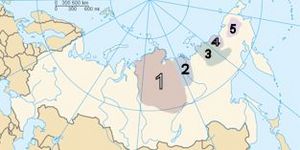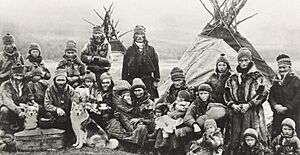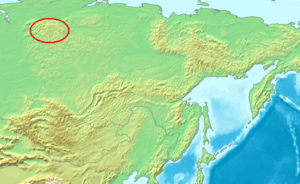Reindeer in Russia facts for kids
Reindeer are amazing animals found in Russia, including both tundra and forest types. They are all part of the same species, Rangifer tarandus. In Russia, you'll find different kinds of reindeer. These include the Novaya Zemlya reindeer, the Sápmi reindeer, and the Siberian tundra reindeer.
Contents
Novaya Zemlya Reindeer
The Novaya Zemlya reindeer (R.t.pearsoni) live on the Novaya Zemlya islands. These islands are in the Arctic Ocean, north of Russia. The Nenets people used to herd these reindeer.
The Nenets are an indigenous group who lived on these islands for many years. They relied on reindeer herding, fishing, and hunting for their food and way of life.
Sami Reindeer
The Sami reindeer (R.t. tarandus) are a type of semi-domesticated reindeer. They are common in a region called Sápmi. Reindeer herds often visit the grassy areas of the Kola Peninsula in summer.
Sami People and Reindeer Herding
The Kola Peninsula was home to the Sami people by the end of the first millennium CE. They mainly focused on herding reindeer and fishing. The Sami are an indigenous group living in parts of Russia, Norway, Sweden, and Finland.
Their most famous way of life was semi-nomadic reindeer herding. This means they moved with their reindeer herds. The Sami are the only indigenous people in Scandinavia recognized by international agreements.
By the late 1800s, many Sami people were pushed north by other groups. In the 1900s, their reindeer herds were brought together into large collective farms. This changed their traditional herding practices. Many Sami were encouraged to settle in villages. This led to some Sami people losing their language and old herding knowledge. Today, many Sami live in cities, but some still herd reindeer.
Siberian Tundra Reindeer
Siberian tundra reindeer (R.t. sibiricus) can be found in different regional groups. These include the Taimyr, Bulun, Yano-Indigirka, and Novosibirsk islands forms.
In central Siberia's Yakutia region, there are three large herds of wild tundra reindeer. These are the Lena-Olenek, Yana-Indigirka, and Sundrun herds. The Lena-Olenek herd is stable, but the others are getting smaller.
Further east, the Chukotka herd is also shrinking. In 1971, there were over half a million animals. Their numbers dropped a lot by 1986 but then recovered. However, by 2009, their population fell again to less than 70,000.
Taimyr Reindeer Herd
The Taimyr reindeer herd is the biggest reindeer herd in the world. It is a migrating tundra reindeer herd (R.t. sibiricus). In the 1950s, there were 110,000 reindeer. By 2000, the herd grew to 1,000,000 animals!
However, by 2006, the number dropped to 700,000, and to 600,000 by 2009. This decrease is partly due to changes in the climate. The Putorana Nature Reserve was created to protect this huge herd and other animals like snow sheep. This reserve is a World Heritage Site.
Taimyr tundra reindeer travel to winter pastures in the Putoran Mountains. They move from the Taz River in the west to the Anabar River in the east.
Forest Reindeer
Forest reindeer are similar to the woodland caribou found in North America. Male wild forest reindeer can weigh between 150 kg and 200 kg. Females are smaller, weighing from 60 kg to 100 kg.
About 10,000 years ago, as ice sheets melted, wild reindeer reached Fennoscandia. Their population was largest in the 1600s and 1700s. At that time, they lived across Eastern Fennoscandia and Northwestern Russia.
By the 1700s, their living areas started to shrink. They were hunted until they disappeared from Finland in the early 1900s. However, they continued to live in remote parts of Russian Karelia. By the early 2000s, their range in Karelia had moved north and become broken up.
Today, wild forest reindeer are found in Russia, in Komi, Arkhangelsk, and Karelia. This species is becoming rare in most parts of Russia. Many are listed as endangered in the Red Book. This includes wild mountain reindeer in Komi and various types of Siberian forest reindeer.
Other populations are listed as vulnerable or rare. This includes the wild forest reindeer in Karelia and mountain reindeer in the Tyumen area.
Reindeer Husbandry
Reindeer husbandry means raising and caring for reindeer. Sayan reindeer herding is thought to be the oldest way of herding reindeer. It began with the Samoyedic people in the Sayan Mountains around 2,000 years ago. This area seems to be where the practice of hunting and herding reindeer started.
Today, there are over two dozen regions in Russia where reindeer husbandry is an important part of the economy. Domestic reindeer look different depending on where they live. Their appearance and behavior change based on their environment.
East Siberian Sea Coast
For many centuries, native peoples lived along the coast of the East Siberian Sea. These included the Yukaghirs and Chukchi people. They practiced reindeer husbandry, fishing, and hunting. Reindeer sleds were very important for travel and hunting.
Later, the Evens and Evenks joined them, and then the Yakuts. These tribes moved north to avoid conflicts with Mongols. They all practiced shamanism, a spiritual belief system, but spoke different languages.
Soyot Reindeer Herding
Researchers have studied the Soyot people and their reindeer herding. In 1926, an expedition looked into Soyot reindeer herding. At that time, it was described as a "dying branch of the economy."
However, later studies showed that the herding tradition continued. It lasted until the mid-1900s when the government became more involved. In 2000, reindeer herding groups in Mongolia and Russia started working together. They aimed to help rebuild reindeer herding traditions.
Some experts believe that the Soyot of Buryatia and other reindeer cultures in Central Asia might have traded and intermarried. This suggests they were connected across the Sayan Mountains.





